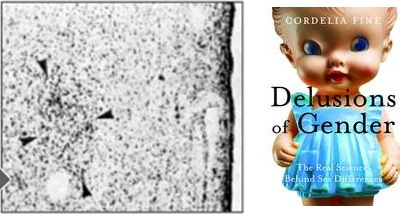
What would Simon LeVay and Cordelia Fine say to each other about the impact of INAH-3 on observed behavior?
Beginning a few years ago, students in my Biological Psychology class began to tell me in class that “we all know that the brain differences between men and women are small and behaviorally insignificant.” The wording of this comment was always the same, so I became curious as to its source. The students were unanimous–they had learned this phrase, not too surprisingly, in their gender studies courses.
Where did the gender studies faculty get this idea? That, too, became apparent when I purchased a copy of Cordelia Fine’s Delusions of Gender, published in 2010, and read it over the summer. Using the interesting term “neurosexism,” Fine, who is herself a trained neuroscientist, argues that biology has little if anything to do with observed differences in male and female behavior, and that studies that purport to show biological differences are inherently flawed. Differences between male and female behavior just simply cannot be the end result of prenatal exposure to androgens, structural differences in the nervous system, and so on according to Fine. She dismisses the work of Laura Allen and Roger Gorski on the sexual dimorphism of INAH-3 with a wave of her literary hand, quoting Gorski himself as saying “We’ve been studying this nucleus for 15 years, and we still don’t know what it does” (Fine, 2010, p. 104).
Students interested in the neuroscience of sexuality might know something more than Fine is telling us about INAH-3. This was the very same structure that appeared in Simon LeVay’s 1991 Science article that set the stage for any public discussion on the biological basis of homosexuality. LeVay reported that INAH-3 differed significantly between heterosexual and homosexual males, with the homosexual male INAH-3 being about the same size as Gorski and Allen’s female samples.
So here is where the party gets interesting. LeVay selected INAH-3 as a likely candidate for a structure that might be different based on sexual orientation precisely because of Gorski and Allen’s work on its sexual dimorphism. LeVay’s observed differences in INAH-3 between homosexual and heterosexual males are smaller and show more overlap between groups compared to Gorski and Allen’s work comparing men and women. If Gorski and Allen’s differences are to be considered small and behaviorally insignificant, LeVay’s logically would be more so. Nor does LeVay know any more than Gorski about the specific functions of INAH, yet Fine makes no mention at all about the implications of the gender differences literature for the understanding of the biological influences on sexual orientation.
The biology of gender differences provides the foundation for any current arguments regarding the biological influences on sexual orientation, making these two research lines inseparable. To argue that observed gender differences have little to do with biology and everything to do with socialization requires one to make the same argument for sexual orientation, but most of us would consider such a proposal to be a shocking and unacceptable throwback to Sigmund Freud’s overbearing mother and passive father.
Good science does not result from picking and choosing your findings to fit your worldview–accepting the biology of sexual orientation but rejecting the biology of gender–but rather from an objective review of the data.

